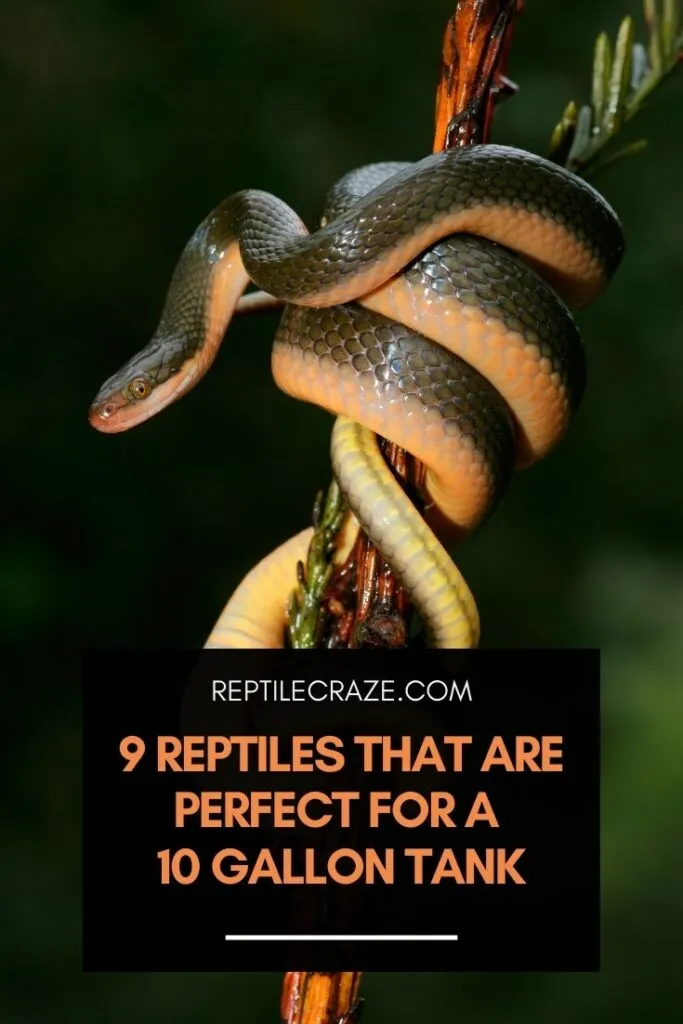
In this article, you will find a listing of 9 reptiles that are ideal for a ten-gallon
Some of the best reptiles you can get for a 10
These pets can live comfortably in a 10
Now the questions start coming: What do you need for each of these creatures’ setups?
What are some pointers about keeping the tanks in good shape, so your pet is comfortable, happy, and enjoys a long life? All this and more will be answered in the forthcoming paragraphs, so join us for some quality info about the care and keeping of these reptiles.
If you’d rather watch a video than read, go ahead and watch our video below on the Top Reptiles for a 10
Table of Contents
9 Great Reptiles For 10 Gallon Tanks
Now, let’s move onto what you came for- the reptiles just right for small tanks.
1. House Gecko
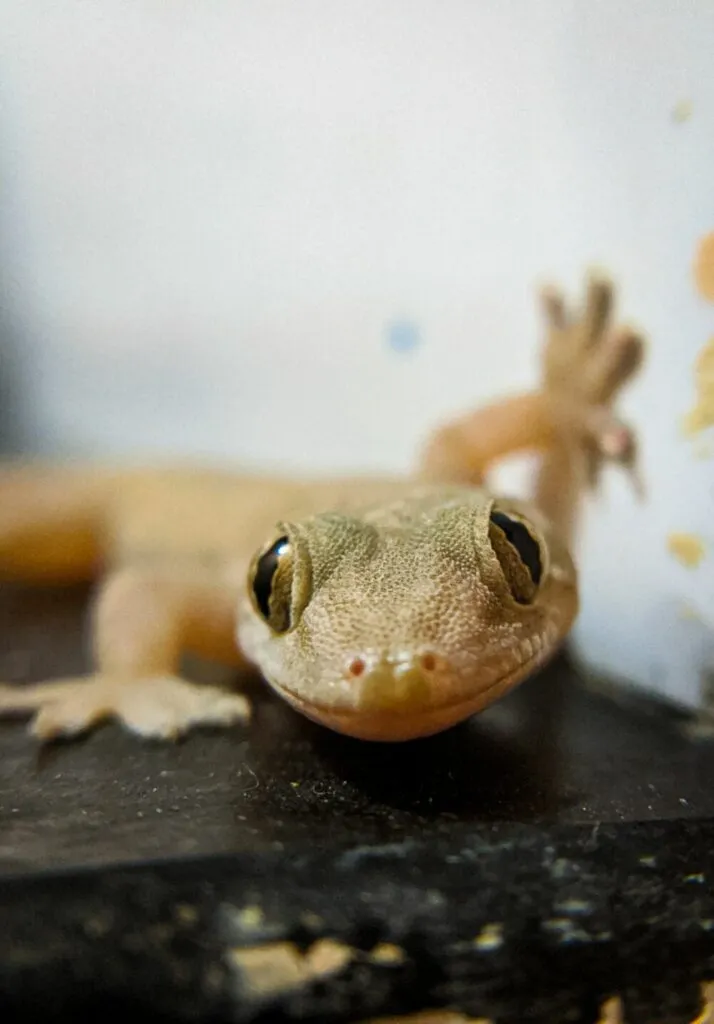
You may hear these little geckos referred to as Turkish geckos or wall geckos. They are only 5 inches long, counting their tail, making them an excellent fit for small 10 gallon tanks.
These geckos require hideouts like coconut shells turned on their sides or even a clay pot placed on its side- even if they are alone in their vivariums. Substrates should be able to retain moisture, so coconut fiber or reptile bark is a great choice.
Avoid the use of reptile carpet or sand- these lack the ability to create a humid zone for your pet. If the substrate is soiled, remove it and replace it with fresh bark or fiber.
Temperature gradients should be 75 to 90F for daytime hours, and night hours should be 65 to 75. As mentioned, ceramic heat elements and reptile bulbs are ideal for creating such temps.
These geckos are nocturnal critters. Therefore, no special UVB lighting is required- but having that UVB light for your gecko to enjoy may help their overall health.
In terms of humidity, geckos prefer 60 to 75%. Be sure you have a hygrometer to accurately measure this and keep it where your gecko needs it to be.
House geckos enjoy eating crickets, mealworms on occasion, and fruit flies. Calcium supplements and multivitamin supplements are also necessary for the health of your gecko.
2. Kenyan Sand Boa
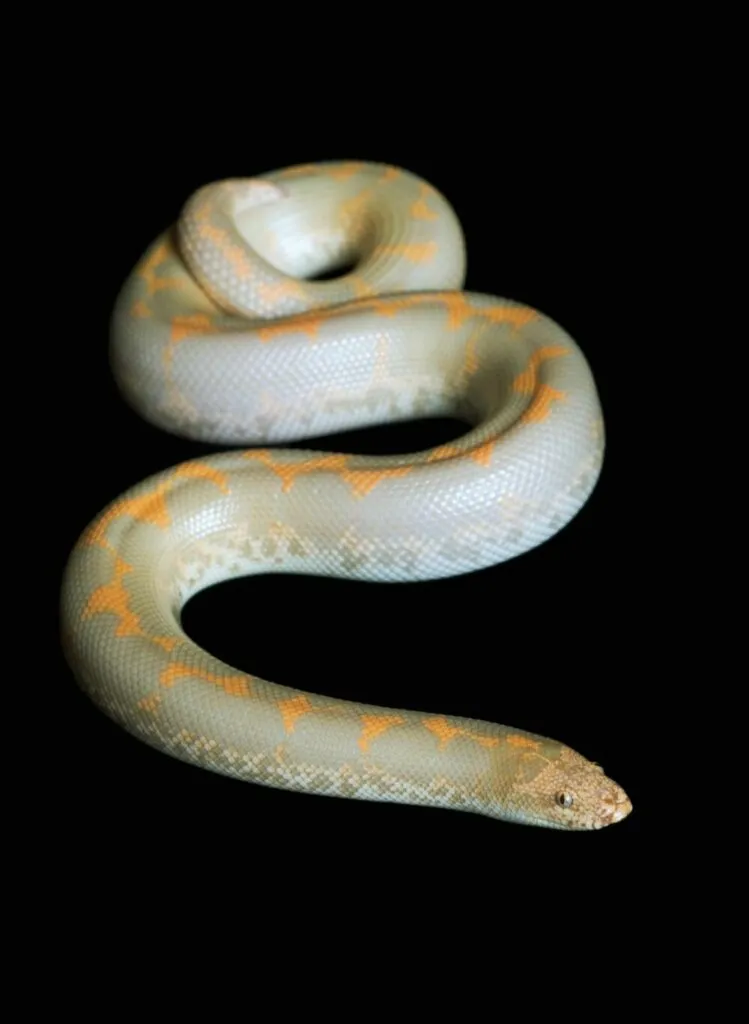
This is a snake, so a vivarium with a secured lid is a must. If you are using a screen lid for your Kenyan Sand Boa, include a heating pad under one side of your enclosure that you leave on 24 hours a day, 7 days a week.
You will also want to provide your snake with an incandescent light that heats the enclosure during the day.
The cooler side of the habitat may be 80F, while the hot spot should be about 95F. For night temps, aim for 75F.
This snake enjoys burrowing, so keep the habitat in a minimal state. Don’t use weighty rocks unless you can secure them to the side of the habitat.
Otherwise, your Kenyan Sand Boa could burrow under the rocks, and if they fall on top of him or her could result in its death.
The snake also tends to be quite destructive, another reason to keep decor to a minimum.
Also read: Reptiles That Are Perfect For 40-Gallon Tanks and Reptiles That Can Live In A 20-Gallon Tank Forever!
For your substrate, sand will work; but you can also use coconut mulch, aspen bedding, or newspaper. Avoid cedar shavings and gravel.
When it comes to
As they get older, frozen or thawed mice will do. You may feed them using tongs or tweezers used ONLY for the feeding of your snake.
3. Madagascar Day Gecko
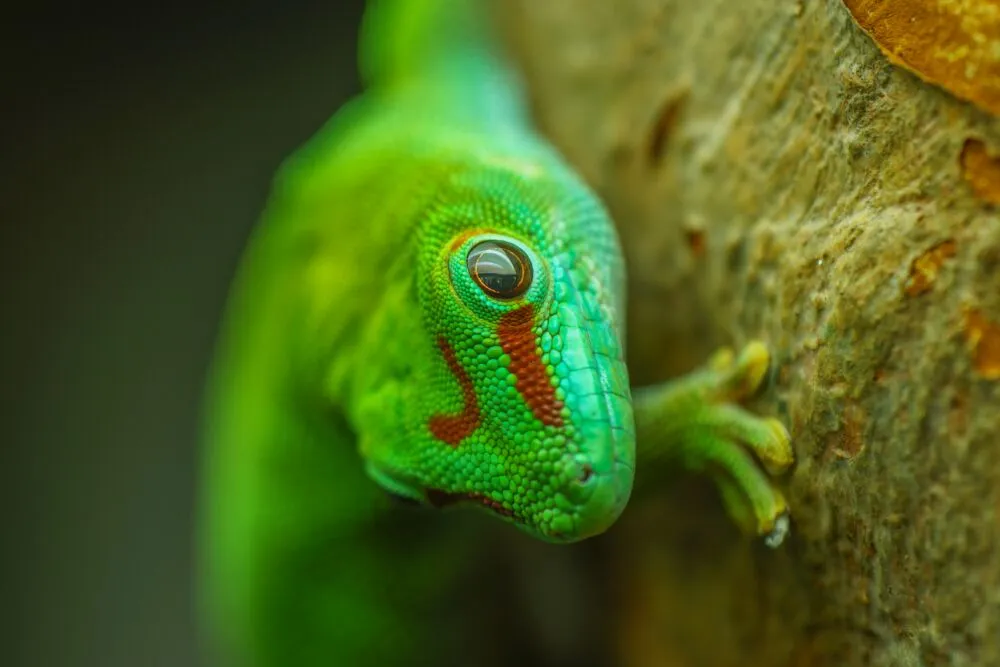
Sometimes called the giant day gecko, these geckos grow to about 10 inches long. They thrive in arboreal vivariums, with humidity levels ideally at 55 to 65%.
They are happiest in temps of 80 to 88F and enjoy basking at about 91F. For the night, you will want to drop the temp down to the low 70s.
These critters need correct lighting so you can enjoy their coloration to the fullest. Look for lights that offer a color-render index of 85 and up, plus one that offers UVB and heat.
You will need to ensure the
For the substrate, begin with a .75” layer of pebbles- clean, reptile grade types- and then use an inch of reptile bark and mix the bark with potting soil that is organic for an ideal ground your gecko will enjoy.
Orchids, sansevierias, and bromeliads are ideal for the Madagascar Day gecko’s enjoyment. You can put them into the soil. Orchids can be placed on the enclosure’s sides.
For water, mist the gecko twice a day using filtered or reverse-osmosis water. Be sure to handle your gecko with the utmost care, as their skin tears off easily, and newcomers to the species are often surprised.
Tip: Wanna know what bigger reptiles you can keep in a 100-gallon tank? Read this article! Wanna go even bigger? Here are reptiles for 120-gallon tanks!
4. Rosy Boa
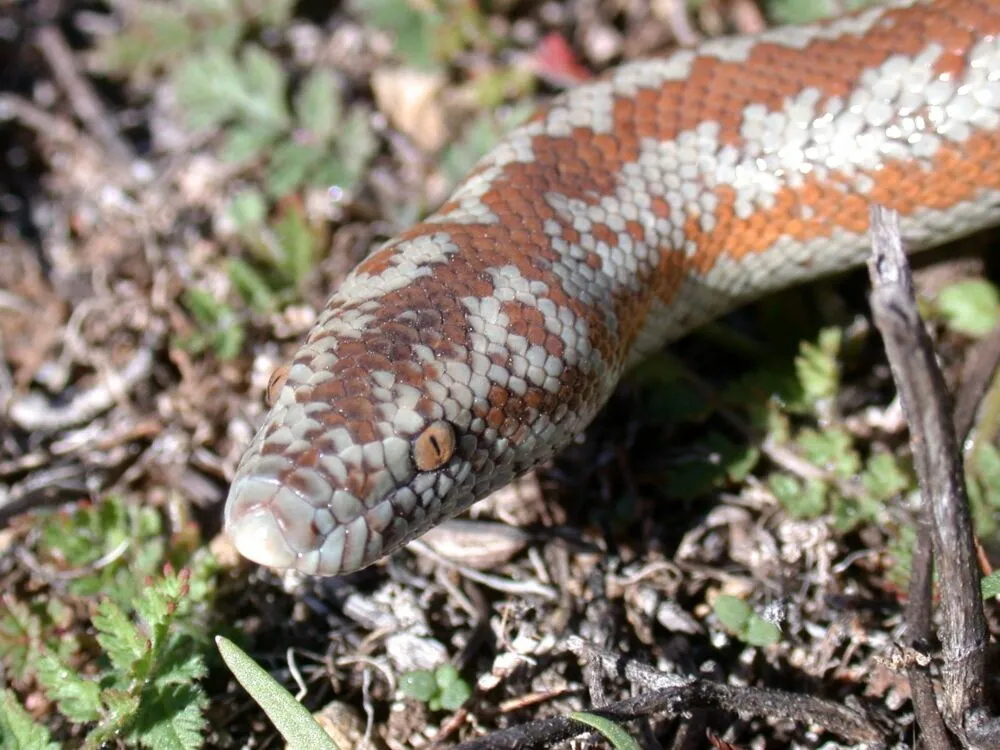
Rosy boas are escape artists, so you must make sure the
Screening is not an ideal choice because the abrasive nature of the screen can cause damage to your snake. If you MUST use a screen, secure it with screen clips like these.
For your substrate, use aspen shavings or paper towels. Heat tape or a heating pad may be utilized for the creation of a temperature gradient. Keep temperatures 80 to 85F.
Rosy boas desire a hide where they can feel safe. You can make one from cardboard or purchase a snake hide from your local pet shop.
This offers the snake a feeling of safety, and they won’t rub their noses on the enclosure. Be sure to place your hides in both cool and warm spots to accommodate your reptile.
When it comes to lighting, your biggest goal will be to create a thermal gradient that lets your snake go wherever they are feeling at the moment.
Use heat tape on one side of your habitat to accomplish this. Make sure you use a thermostat- namely, a pulse-proportional thermostat- to keep the temperature just right for your rosy boa.
Wanna learn more about rosy boas? Read our rosy boa care guide!
5. Pygmy Chameleon
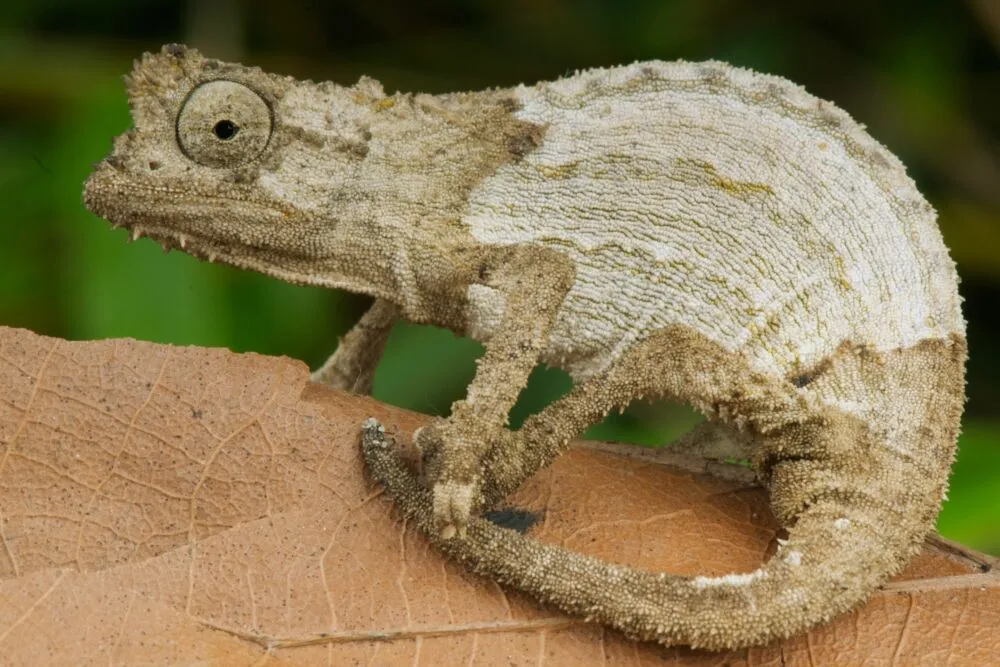
One great thing about pygmy chameleons is that they are low-maintenance creatures. They can even be housed in a five-gallon
Setting up the habitat is relatively easy to do. These are friendly critters that enjoy life on the forest floor and do well in an enclosure that is well-decked out in plants, whether these are real or synthetic. This helps your chameleons hide and feel a sense of safety.
Make sure that all plants, whether real or fake, are cleaned properly before being placed into the habitat. Real plants pose the risk of pesticides; artificial plants can have harmful germs on them.
For the substrate, coconut bedding works well; anywhere from 2-4 inches is appropriate. You will also want to put a layer of pebbles under the bedding to help drain the plants. Small sticks and branches give the pygmy chameleon a place to climb.
For temperatures, these versatile creatures enjoy anything from 70F to 80F. Pygmy chameleons do not require you to create a temperature gradient, nor do they need UVB lights.
After all, they live on the forest floor in the wild- here, the sunlight doesn’t reach as far. Keep their light cycle as 12 hours on and 12 hours off. For temperature, you might do 80F during the day and 75F at night.
For humidity, keep it between 60 to 80% and mist the habitat twice per day for best results.
Tip: Wanna learn about reptiles that can live in 5-Gallon tanks? Read this article!
6. Green Anole
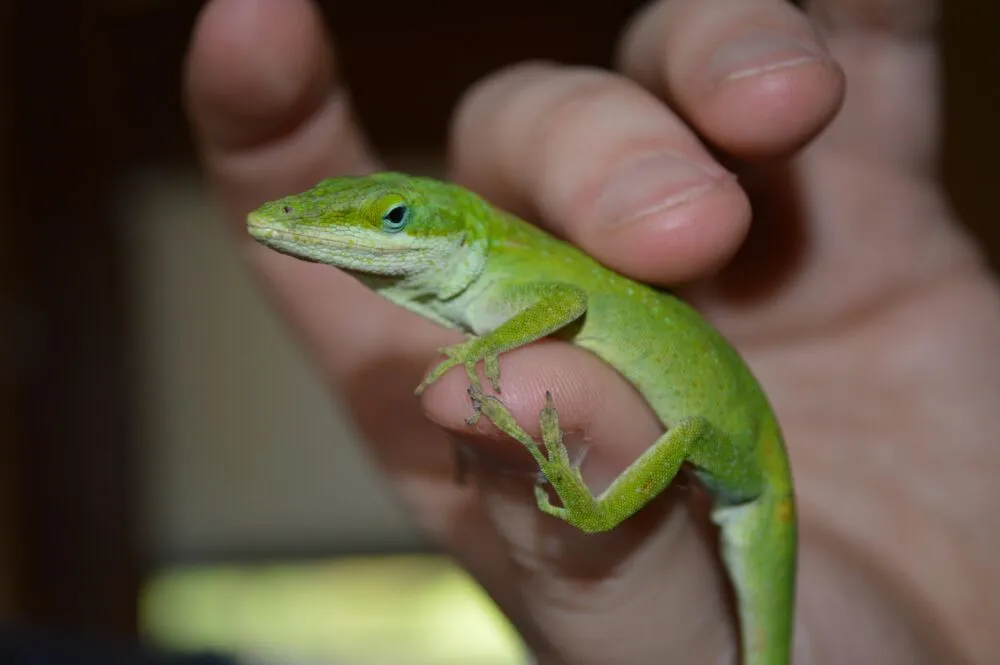
One anole can fit comfortably in a 10
You can use coconut fiber or moss as the bedding for your anole; aim for about 3 inches of depth. Extra moss can help you bring up the humidity level. You will need to change this once a month, so go with what you can afford.
Tip: If you want to get a green anole, read our green anole care guide here!
Anoles need to hide, so be sure to offer them hiding spots using wood, rocks, coconut shells, or pots. To keep your anole entertained, offer them branches and live plants for climbing.
Anoles need a temp ranging from 85F to 90F at the top of their habitat, and at the bottom 75 to 85F is appropriate.
You can use a ceramic heating element or bulb to keep it warm, and a thermometer at the top and bottom of the habitat will help you keep an eye on the temp. Use a hygrometer to keep track of the humidity, which should be 60 to 80%.
Keep their water dish full and be sure to mist the habitat twice a day at a minimum. Moss and coconut fiber is excellent for retaining moisture. Since anoles are diurnal, you will need to create 12-hour day and night cycles using UVA/UVB bulbs.
Tip: Find out what reptiles can be housed in a 30-Gallon tank here!
7. Crested Gecko
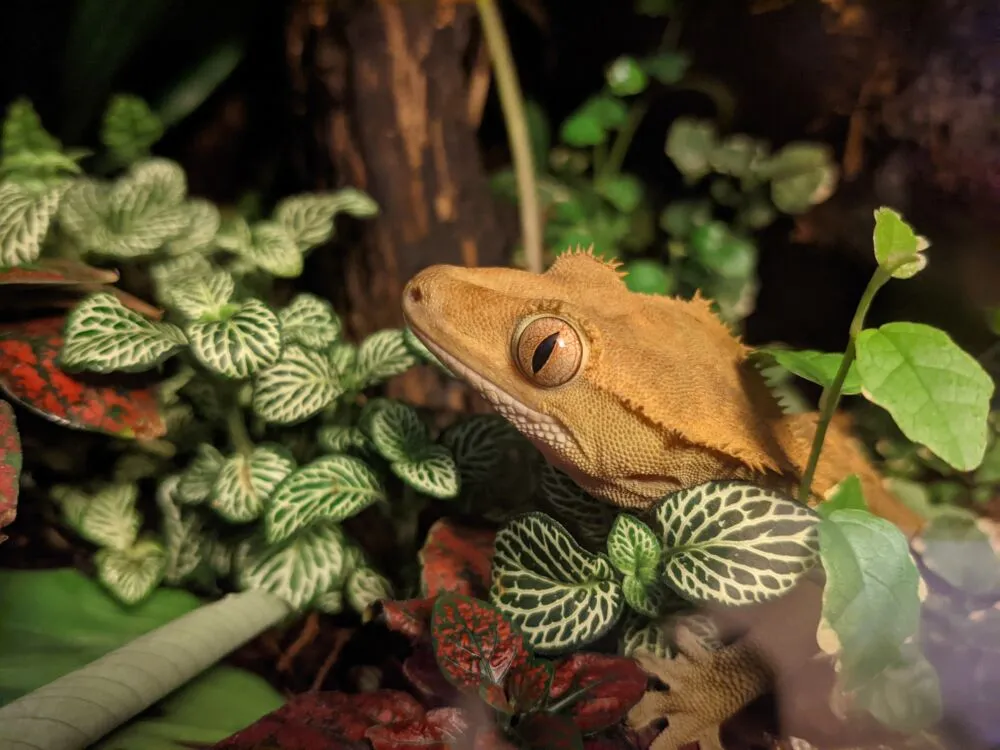
Here again, we stress the importance of a secure cover on your crested gecko habitat, and the higher your habitat walls can go, the better. These guys are climbers, after all.
You will need to offer your crested gecko plenty of branches and plenty of hiding places. Synthetic or real plants are also welcome. Be sure humidity is kept between 60 to 80% and utilize a hygrometer to monitor it. You can help keep it humid by misting the habitat twice a day.
Substrates can be coconut fiber, bark, or sphagnum moss. For temps, keep the daytime at 75 to 82F, and for night, go for 68 to 75F. A low-watt heat lamp is good for this; radiant heat is also OK.
Light should be offered to your crested gecko for 12 hours a day. If you are not using a nocturnal incandescent bulb or ceramic heater, use an incandescent day bulb for your gecko’s basking area.
- (Do you need more information on crested geckos and how to care for them? Have a look at our articles here!)
These critters are nocturnal, so it is not uncommon to see them in their hiding spots during the day. Watch to see them jumping from branch to branch- this is common behavior.
Owners should be careful to handle their gecko with care as stressful situations can cause them to drop their tails which do not grow back. Crested geckos will lick their eyeballs to keep them moist- this behavior is normal.
8. Leopard Gecko

These adorable geckos are favored for their many morphs and their seemingly smiling faces. A single Leopard gecko does fine in a 10
- (Do you need more information on leopard geckos and how to care for them? Have a look at our articles here!)
Keep the habitat warm- you will need a cool side and warm side of the
On the warm side, shoot for 80 to 90F and 75 to 80F on the cooler side. Humidity should be 10% to 30%. Leos require 12 hours a day, and a low-watt UVA/UVB light is fine for this purpose.
For substrate, you can use a semi-arid bioactive option, or you can use reptile carpet. If your Leo measures 6 in or less, just use reptile carpet to minimize the risk of swallowing substrate.
Make sure your leopard gecko has hides on either side of the
9. African House Snake

For these snakes, start with a substrate of aspen or beech chips. Layer them thick so your snake can burrow comfortably into the substrate. Paper towels or newspapers can work, too.
For your snake to behave naturally and climb as they are wont to do, offer them plenty of plants and branches to climb upon. Fake ones are OK for this purpose. You should add these in both the cool and warm side of the habitat.
You can use a ceramic light or heating pads to make it warm on one side of the
Use thermometers to make sure these temps stay consistent. UVB light is fine to use but is not necessary for the African house snake.
When it comes to humidity, keep it between 30 to 50%.
Lightly misting the
Tip: Would you like to know what reptiles can live in a 75-Gallon tank? Read this article!
One thing to note is that African house snakes enjoy the water as it helps them shed their skin. Be sure you change out the water on a frequent basis, so your snake stays healthy while in the water bowl.
Choosing A Great Setup
To purchase a great reptile setup is not something you can do on a whim. You must be ready to put a solid chunk of time into its planning before you buy it. On that note, we’d like to talk about what it takes to make a reptile setup great.
Basic Vivarium Pointers
A vivarium is a term given to a reptile habitat that you set up in your home. It must be designed in a way that is accommodating to the reptile you have chosen to keep. This will keep them healthy and comfortable.
Here’s our best advice for making your first setup a smooth one:
1. Be Ready Ahead of Time
Before bringing your pet home, make sure the vivarium is set up first. Make sure you read and research what your particular reptile needs and gather all supplies first.
Figure out what sort of environment your pet needs, and make sure you establish it well in advance of your new pet arriving home.
Setting it up ahead of time- such as one week before you are scheduled prior to pick up your reptile- will give it time to become stable, and you can verify all lamps, thermometers, and other equipment is working properly.
It will ultimately make the stressful transition from the pet shop or breeder to your home a smooth and easy one.
2. Choose A Great Tank
You can use a regular 10 gallon aquarium
Glass is also better equipped to handle the moisture and heat associated with a reptile home. And if you can, always go bigger. For example, if you can afford a 15 or 20-gallon
3. Select the Right Substrate
Ask your pet store employees or breeder about what substrate is best for your pet. By choosing the wrong one, you could make your pet fatally sick or even make cleaning the
Reptile carpet, peat moss, or even newspaper can work depending on the reptile, so be sure to consult an expert.
4. Make Sure It’s Warm
Many reptiles are what we call arboreal, meaning they like to remain in trees or other above-ground structures as it feels safe.
Make sure you have plenty of objects they can use to climb upon in the
- Ambient heat usually comes from a ceramic heat element that’s plugged into a light socket OR an overhead lamp. Make sure the reptile cannot touch either of these, as they can and will burn your pet.
- Always provide a cool hide for your pet to enjoy.
- Only part of your vivarium needs to be equipped with digestive heat; the rest may be ambient heat. Keep the digestive heat on 24 hours so your pet can use it when they need to.
- Heat is necessary thanks to reptiles being cold-blooded creatures.
5. Lighting Advice
Day and night cycles must be established using the lighting in your aquarium. It will help your pet digest their
Utilizing a full-spectrum bulb will help you get the much-needed UV lighting in your vivarium. This will make it easier for your reptile to create vitamin D3, which they use to metabolize calcium.
6. Covering the Vivarium
Lids are necessary for your vivarium, especially in the case of snakes that are known to escape.
Make sure your lid can do the following:
- Offers a barricade between the lighting/heating equipment and the animal. Most people use a screen to do this. Do not use a glass cover as it filters the heat away and filters out UV wavelengths from the lighting equipment.
- It offers a small space for cords attached to the heating equipment to go out of your
tank and ensures these cords are not chewable/able to be touched by reptile claws or teeth.
In Conclusion
There you have it- 9 great reptiles you can enjoy with just a 10
- Enchi Ball Python: A Unique and Stunning Morph of Python regius - March 27, 2025
- Emerald Tree Monitor: The Enigmatic Green Guardian of the Rainforest - March 26, 2025
- The Egyptian Cobra (Naja haje): A Fascinating Serpent - March 25, 2025
